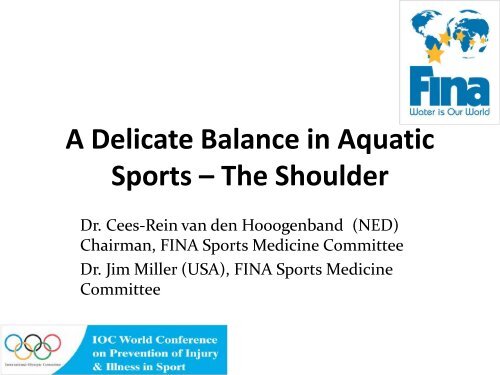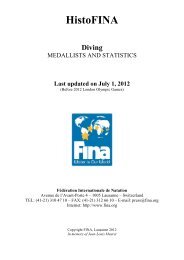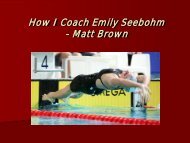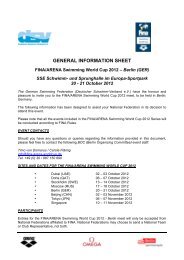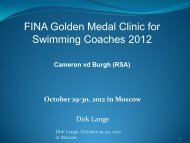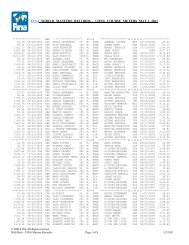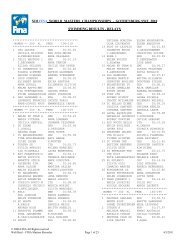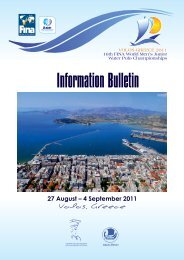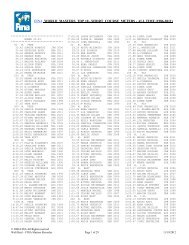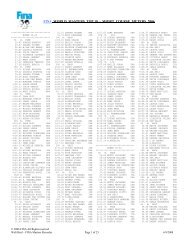download presentation in pdf - Fina
download presentation in pdf - Fina
download presentation in pdf - Fina
Create successful ePaper yourself
Turn your PDF publications into a flip-book with our unique Google optimized e-Paper software.
A Delicate Balance <strong>in</strong> Aquatic<br />
Sports – The Shoulder<br />
Dr. Cees-Re<strong>in</strong> van den Hooogenband (NED)<br />
Chairman, FINA Sports Medic<strong>in</strong>e Committee<br />
Dr. Jim Miller (USA), FINA Sports Medic<strong>in</strong>e<br />
Committee
Why Aquatic<br />
Athletes?
Application to Aquatic Sports<br />
Synchronized swimm<strong>in</strong>g – throws, lifts,<br />
land<strong>in</strong>gs/impact; overuse<br />
Div<strong>in</strong>g – impact forces, <strong>in</strong>creased with errant<br />
entry<br />
Water Polo – impact from contact; throw<strong>in</strong>g<br />
motion; overuse<br />
Swimm<strong>in</strong>g – classic overuse, exacerbated by jo<strong>in</strong>t<br />
<strong>in</strong>stability<br />
Open water swimm<strong>in</strong>g – extreme overuse (races<br />
of 5K to 25K or more); impact from contact
How Much<br />
Shoulder Load?<br />
Upper extremity<br />
provides up to 90% of the<br />
propulsive power <strong>in</strong><br />
swimm<strong>in</strong>g.<br />
60-85% of all elite level<br />
swimmers will have a<br />
pa<strong>in</strong>ful shoulder<br />
requir<strong>in</strong>g a layoff of a<br />
week or more.<br />
……and then there are<br />
the other aquatic<br />
discipl<strong>in</strong>es which are far<br />
more than just rotations.
Math is Compell<strong>in</strong>g<br />
Rotations<br />
10,000 – 30,000<br />
meters/day<br />
35 rotations (or more) per<br />
50 meters<br />
Over 50,000 - 120,000<br />
rotations per week!!!<br />
This does not account for<br />
lifts, boost and scull<strong>in</strong>g,<br />
throw<strong>in</strong>g, land<strong>in</strong>gs
Technique is Critical
Balance<br />
Aquatic sports and<br />
imbalance – stimulat<strong>in</strong>g<br />
some muscle groups<br />
while destabiliz<strong>in</strong>g others<br />
(e.g. front vs. back<br />
stabilizers and posture)<br />
Tra<strong>in</strong><strong>in</strong>g duration and<br />
<strong>in</strong>tensity lead to fatigue<br />
and small stabilizer<br />
failure
Muscle Balance<br />
Front to Back<br />
Left to Right<br />
Small to Large<br />
Fir<strong>in</strong>g Sequence<br />
Balance<br />
Is this balance?
Static Stabilizers<br />
Boney Static Stabilizers Tendon Static Stabilizers
Dynamic Shoulder Stabilizers<br />
Extr<strong>in</strong>sic Muscle Stabilizers Intr<strong>in</strong>sic Muscle Stabilizers
Stabilizers - Dynamic<br />
All <strong>in</strong> “force<br />
couple” balance
Force Couple Breakdown<br />
Fatigue of<br />
smaller stabilizers<br />
needed to center<br />
humeral head<br />
Result: forward<br />
and upward<br />
movement of<br />
humeral head
Factors Contribut<strong>in</strong>g to Failure<br />
• Genetics<br />
Multi-axial <strong>in</strong>stability<br />
Static Stabilizer<br />
abnormalities<br />
• Technique<br />
• Core Failure<br />
• Sudden Change <strong>in</strong><br />
Tra<strong>in</strong><strong>in</strong>g Program<br />
• Trauma
Trauma
Trauma
Trauma
Quality Assessment of<br />
Diagnostic Accuracy<br />
Studies(QUADAS)
Assessment of Instability<br />
Apprehension Test<br />
Sensitivity:60%<br />
Specificity:95%
Apprehension Test
Assessment of Instability<br />
Relocation Test<br />
Sensitivity:70%<br />
Specificity:95%%
Relocation Test
Assessment of Instability<br />
Anterior Release Test<br />
Sensitivity:90%<br />
Specificity:90%
Anterior Release Test
Traumatic Shoulder<br />
Operative<br />
treatment<br />
after first<br />
trauma?<br />
Dislocation
Recurrent Shoulder Dislocation(or<br />
Subluxation)<br />
Unidirectional or Multidirectional?
Specialist (Orthopaedic)<br />
Assessment of Instability<br />
Radiographic tools:<br />
MRI/CT scan
Stretch<strong>in</strong>g<br />
Is all stretch<strong>in</strong>g good?<br />
What are you<br />
stretch<strong>in</strong>g??<br />
NO!
Stretch<strong>in</strong>g Pr<strong>in</strong>ciples<br />
In case of recurrent subluxation or <strong>in</strong>stability<br />
NO STRETCHING!<br />
Warm up before tra<strong>in</strong><strong>in</strong>g or competition is<br />
enough!<br />
In the case of the stable shoulder, do not<br />
CREATE the <strong>in</strong>stability!
Common, but “Bad” Stretches
FINA Shoulder Project<br />
Goal: Provide a video <strong>presentation</strong> that outl<strong>in</strong>es<br />
simple exercises which will have an impact on<br />
reduc<strong>in</strong>g the alarm<strong>in</strong>g prevalence of shoulder <strong>in</strong>juries<br />
<strong>in</strong> the aquatic sports<br />
Organization: Three ma<strong>in</strong> group<strong>in</strong>gs of exercises –<br />
Core, Scapula, and Rotator Cuff – featur<strong>in</strong>g 4<br />
exercises each<br />
Exercises chosen to m<strong>in</strong>imize use of required<br />
equipment
Core Exercise #1 - Quadraped<br />
• Lift<strong>in</strong>g opposite arm and leg simultaneously<br />
• Builds up to hold<strong>in</strong>g position for at least 30<br />
seconds<br />
• Each side repeated for 3-6 times.<br />
• Balance ball <strong>in</strong>troduces additional level of core<br />
fir<strong>in</strong>g<br />
• Stabilizes core <strong>in</strong> a free float<strong>in</strong>g environment -<br />
l<strong>in</strong>k<strong>in</strong>g
Quadraped
Core Exercise #2 – Dead Bug<br />
• Basic version – Athlete ly<strong>in</strong>g on back with<br />
arms under upper hips and lower back; back<br />
pressed aga<strong>in</strong>st hands to flatten back<br />
• Athlete lifts both legs off of ground and<br />
performs tight flutter kick<strong>in</strong>g<br />
• Build<strong>in</strong>g up to a 30 second; 3-6 repetitions
• Advanced version – athlete raises one arm and<br />
contralateral (opposite) leg or one arm and<br />
ipsilateral (same) leg<br />
o Opposite leg – focus is on cross-l<strong>in</strong>k<strong>in</strong>g<br />
o Same side leg – focus is on l<strong>in</strong>e stabilization<br />
• Builds strength and balance l<strong>in</strong>k<strong>in</strong>g ipsilateral<br />
and contralateral sides
Core Exercise #3 – Side Plank Raises<br />
•Involves lift<strong>in</strong>g of hips from side plank position to<br />
form straight l<strong>in</strong>e with body<br />
• Core should be engaged at all times to ma<strong>in</strong>ta<strong>in</strong><br />
proper body alignment.<br />
• For advanced version, extend non-support<strong>in</strong>g arm to<br />
form T<br />
•Repeat the exercise at least 3-6 times hold<strong>in</strong>g for 30<br />
seconds – rest – and then go to the other side<br />
•Strength and balance
Side Plank Raises
Core Exercise #4 – Chair pelvic tilt with<br />
three-way crunch<br />
•Athlete lays on back with lower legs rest<strong>in</strong>g on chair<br />
•Uses <strong>in</strong>ner abs to flatten lower back and press it <strong>in</strong>to<br />
ground (pelvic tilt)<br />
•Then performs 3 crunches: middle, left and right,<br />
hold<strong>in</strong>g each for 2 seconds; ma<strong>in</strong>ta<strong>in</strong> pelvic tilt<br />
•Power development comb<strong>in</strong>ed with rotation – ideal<br />
for aquatic sports
Scapular Exercise #1 – Scapular Push-Up<br />
• Athlete <strong>in</strong> ‘push-up’ position on hands and feet or hands and<br />
knees, shoulder blades relaxed<br />
• Glide scapulae toward each other posteriorly <strong>in</strong> squeez<strong>in</strong>g<br />
motion (note swimsuit straps to show location of the<br />
scapulae)<br />
• Works strength as well as symmetry of motion
Scapular exercise #2 – Hitch hiker<br />
•Athlete lies face down with arms at 90 degrees to body<br />
•Arms are raised directly off of surface and up, while<br />
squeez<strong>in</strong>g scapulae together (note swimsuit straps aga<strong>in</strong>)<br />
•Up to 20 repetitions per set; 3-6 sets<br />
•Works l<strong>in</strong>k<strong>in</strong>g and endurance – can identify asymetry
Scapular Exercise #3 – Isolated Shrug<br />
•Athlete lifts weight on one side, us<strong>in</strong>g scapula to glide over ribs to lift<br />
and lower weight<br />
•Build up to 20 repetitions per side, 3-6 sets, with attention to correct<br />
form throughout<br />
Isolation of scapula for strengthen<strong>in</strong>g and sequenc<strong>in</strong>g
Scapular Exercise #4 – Swimmer<br />
•Seated on a balance ball or chair and lean<strong>in</strong>g<br />
forward, hold<strong>in</strong>g light ball or weight
•Athlete br<strong>in</strong>gs arms beh<strong>in</strong>d body and back and perform 3-5 quick<br />
oscillation raises<br />
•Then returns arms to start<strong>in</strong>g position
•Athlete then drops arms down through legs with shoulder <strong>in</strong>ternal<br />
rotation (you should feel a slight stretch) and extend legs for hamstr<strong>in</strong>g<br />
stretch (for only 2-3 seconds)<br />
•Return to start<strong>in</strong>g position and repeat sequence.<br />
•Complex motions with focus on scapular l<strong>in</strong>k<strong>in</strong>g <strong>in</strong> a fashion that<br />
builds endurance and balance
Rotator Cuff Exercise #1 – Ball on the<br />
Wall<br />
• Athlete rolls ball on wall <strong>in</strong> all directions, with<br />
straight arm<br />
• 30 seconds duration, 3-6 sets<br />
• Accomplishes fir<strong>in</strong>g of multiple rotator cuff muscles<br />
• If one shoulder fatigues more quickly than other,<br />
ma<strong>in</strong>ta<strong>in</strong> ‘good shoulder’ at low repeat count until<br />
weaker shoulder catches up; important for<br />
symmetrical stroke development
Rotator Cuff Exercise #2 – Shake It Up<br />
•Water bottle is only equipment needed – size and amount of<br />
fluid can vary as strength develops<br />
•With forward shoulder flexion and elbow at 90 degree bend,<br />
athlete rocks water bottle back and forth quickly along same<br />
plane as upper arm<br />
•30 seconds duration, 6-10 sets per arm<br />
•Rotator cuff endurance and fir<strong>in</strong>g sequence<br />
along with isolation
Rotator exercise #3 – Internal and External<br />
Rotation<br />
•Surgical tub<strong>in</strong>g or thick elastic cords work well, with weight<br />
rack as alternative<br />
•Athlete stands with side to the cords or weight mach<strong>in</strong>e,<br />
with elbow tight to waist<br />
•Shoulder and hand rotated <strong>in</strong>ward for <strong>in</strong>ternal rotation<br />
•Shoulder and hand rotated outward for outward rotation<br />
•Classic <strong>in</strong>ternal and external<br />
rotator strengthen<strong>in</strong>g and<br />
balance
Rotator Cuff Exercise #4 – Drop and Catch<br />
• Equipment – lightweight object that fits <strong>in</strong>to hand<br />
•Athlete holds small weight, roll of tape or a water of bottle<br />
with arm extended straight<br />
• While keep<strong>in</strong>g arm <strong>in</strong> the 90 degree forward extension and<br />
15 degree horizontal adduction, drop and catch the object,<br />
with quick oscillations with<strong>in</strong> six <strong>in</strong>ch vertical distance<br />
• Ma<strong>in</strong>ta<strong>in</strong> good posture with scapulae squeezed down and<br />
back.<br />
•3-6 sets of 20 repetitions.<br />
•Rotator cuff condition<strong>in</strong>g and fir<strong>in</strong>g sequenc<strong>in</strong>g<br />
•
Thank you for your<br />
Attention.<br />
Questions?<br />
Dr. Cees-Re<strong>in</strong> van den Hooogenband (NED)<br />
Chairman, FINA Sports Medic<strong>in</strong>e Committee<br />
Dr. James W. Miller<br />
FINA Sports Medic<strong>in</strong>e Committee


